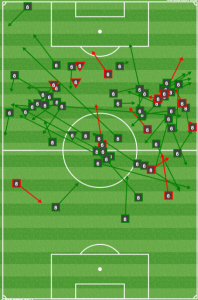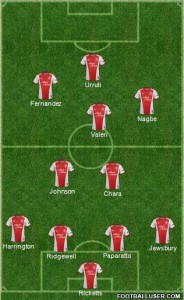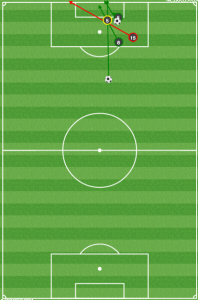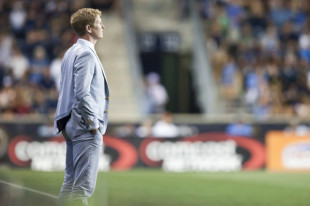Photo: Daniel Gajdamowicz
Remember Porterball? You should.
It was only last season that decorated Akron head coach Caleb Porter made the leap to MLS, taking the reigns of a rudderless Portland Timbers team and turning them into a contender.
He did it with style. He did it with an attack-first bent. He did it in a tough Western Conference. And he did it in a league that desperately needed a manager with star power.
So when the going was good, you better believe MLS was there to tell you how good it was (sidenote: “Porterball” all but disappeared from the MLSSoccer.com lexicon after the man himself went onto the website’s podcast and said he hated it).

RSL kept Valeri and Nagbe out of the middle and off the ball. Note zero successful dribbles for the duo.
And as Matt Doyle highlighted in his 2014 season preview, one reason to bet on Portland to stay near the top was their dynamic midfield duo: Will Johnson and Diego Chara. But while Doyle was praising the pair’s defensive work, he neglected the extremely important role they played in Porter’s offense. In 2013, teams pressed Johnson and Chara, assuming they would be easier targets than the technically gifted Diego Valeri and Darlington Nagbe. As the opposition chased Johnson and Chara, the creative attackers found all the space they needed to shine very bright indeed.
While MLS began to catch up with Portland during 2013 (deep-sitting opponents forced Porter to adopt a more direct style as the season wore on), it was Real Salt Lake’s playoff demolition of the Timbers that fit the final piece into the puzzle.
Porterball punctured
Salt Lake’s tight diamond was less aggressive, and forced Chara and Johnson to step higher. Javier Morales took advantage of the space Portland’s midfielders left behind in a dominant display of modern attacking play. But most teams don’t have a Javier Morales to turn loose on the Timbers. They needed another way to counter Portland’s possession-based offense. And the Philadelphia Union pointed the way.
The Union opened the 2014 season by showing that an organized defense could blunt Portland’s offensive firepower. It would be disingenuous, however, to suggest Philly had figured the Timbers out when Darlington Nagbe had as many key passes as the entire Union squad. Instead, that match revealed to the rest of the league that the Timbers had become one-dimensional. And when their four attackers could not create space with movement, the offense stuttered to a halt (the Timbers’ record with the larger Fanendo Adi starting over Max Urruti shows how much they need a hold up dimension to their offense). Johnson and Chara could not break down a defense on their own.
Throughout 2014, opposing teams have sat deep and compressed space in the final third, comfortable in the knowledge that the Timbers are unwilling to devise a backup plan (despite the team’s 4-2-3 record when hold up specialist Fenando Adi starts, Porter insists on deploying Max Urruti at striker).
And as Portland commits bodies forward to try and force a way through, they lose shape and give up chances. Johnson and Chara, instead of covering the middle of the pitch, are pulled wide or caught high. Is this starting to sound familiar?
Philly’s defensive troubles
It is exactly the same issue the Union have had all season. Two holding midfielders, in theory, means double the coverage in front of the back four. But it has proven an extremely difficult formation to maintain for ninety minutes. In 2013, Portland’s high possession numbers papered over the system’s flaws. But this season both the Timbers and Union have fallen victim to a scheme that tends to fall apart under the weight of its own complexity.
Think about the 4-4-2. Think about how many high-priced striker pairings have been lights-out successful for both players. Surprisingly few.
Two heads really better than one?
It is extremely difficult to read and react to a teammate. When the patterns of play are consistent, it is easier to predict teammate actions. Patterns rarely repeat around the boxes in soccer. It is that unpredictability, that creativity, that leads to chances. Thus, it is hard to find strike partners who are consistently on the same page.
This same logic (at least partially) explains why soccer began moving to 4-1-4-1/4-5-1 systems. A five-man midfield simplifies roles. The destroyer. The shuttler. The creator. Well-defined roles nurture strong play. As revolutionary and exciting as the Dutch Total Football system was, there is a reason it is much harder to pull off successfully than a park-the-bus setup.
Placing two players in a holding role is enticing because it means one can jump into the offense while the other sits in front of the back line. And moments later the roles can switch, catching a defense off guard. Defensively, when the ball is played wide, a holding player can step to the wing as cover while the other holds the middle. It really does sound too good to fail.
Yet, a quick tour around the league finds that of the four teams that have given up over forty goals so far this year, Houston Dynamo are the only team that does not regularly play with a pair of holding midfielders.
It is worth stating again: It is extremely difficult to read and react to a teammate. Diego Chara and Will Johnson were astonishly good at it in 2013, but they have been unable to replicate the feat this year. Under Jim Curtin, the Philadelphia Union have similarly struggled to find the defensive form to match their white-hot offense. And on the surface, it has been hard to figure out why.
A hole in the middle
Sure, Philly has made mistakes. Maybe Ray Gaddis times his leap right on the second San Jose goal or Fabinho doesn’t slam the ball off Sheanon Williams in Dallas. But there have been few outright defensive errors this season (Gaddis and Williams each have one, according to Opta stats).
The real problem has been that the Union’s (and Portland’s, for that matter) defensive system has resulted in a copious amount of shots allowed from prime locations. Philadelphia gives up 63% of shots against inside the 18 yard box. Only Chicago gives up more. And no team in MLS approaches Philly’s 68% of shots given up from the middle third of the pitch. Think about that: The Union often play with three central midfielders to their opponents’ two; the shooting space they give up is where they should be strongest.
Six deep but still weak
The real point here is that in adopting a deep, compact defensive structure, Philly has not drastically improved their defense. Instead, it has revealed an offensive system perfectly suited to the flaws of MLS. The league struggles against quick transitions due to a still-weak pool of outside backs, and the typical winger remains more a physical specimen (meant descriptively, not pejoratively) than a creator. The breathtaking speed of Philadelphia’s counterattack has only been contained by their own busy schedule thus far.
Invert the triangle, flip the script
But the defensive problem remains. And it needs fixing. Luckily, there is a clear solution: Invert the triangle and simplify the midfield roles. Instead of two holding midfielders, put a single central midfielder deep and pair the other with Vincent “Le Vagabond” Nogueira. The Frenchman’s wandering ways call out for a stable central presence, while a lone holding midfielder allows that player to spend more time in the dangerous zone at the top of the box and less time chasing wide.
Philadelphia’s offensive success under Jim Curtin is no fluke. But it is worth pointing out that since Curtin took over on June 10, the Union have only played three teams currently in playoff position (Dallas (L), New York (W), and KC (T)). As San Jose’s near-comeback on Sunday showed, to compete with the clubs at the top, Philly will have to do more than just recruit better defenders. They will have to tweak the tactics that are largely responsible for their recent run of success.
Jim Curtin is finding out that sometimes the big changes are a lot easier to implement than the small ones.




Very interesting Adam… if Curtin were to flip the triangle, what line up would you trot out in this new formation? Assume Maidana is healthy now…
I have always been a fan of the single holding midfielder. I think it simplifies things defensively. I know some think it is silly for me to say, but I hope Edu moves on at the end of the season and Okugo is given the holding role himself and Chaco is the 10 and Le Vagabond is given license to roam which would be your inverted pyramid. I think Okugo is good enough and smart enough to be a destroyer and play linker and at times deep lying playmaker. I know I know. Okugo sycophant.
I agree about Edu. I think he’s played okay, but not at the current price. If he were to come down (which he’d never do) to the $250-300k range I’d say keep him on, but to me he just hasn’t done enough to warrant his current price of $600k, and especially not in a league with such a tight cap. We’re back logged at DM as it is, and while he’s provided good cover at CB, that has largely been fixed and could be fixed even more in the off-season if need be. We could also use that extra money to spread around for pay increases or buy 2 quality players with that.
sure and to see it through further, keep Carroll on to spot Amobi rest or bring up the Harrisburg holding mid which has been Ribero at times for the games that Okugo needs a breather— which wouldn’t be many anyway.
.
I watch almost every Barca game and Busquets doesn’t get many nights off.
Our backline anchor, CV, has only been here a month. We’ve rotated multiple players in many permutations in the back 6. Possession has to be harder to keep when you don’t know your teammates’ tendencies in real game conditions. How much of the problem of opposition quality shots is frequency of turnovers during build up, catching defenders out of position? The tweaks may be more a case of a stable starting 6.
Just keep Brian Carroll out of the equation and watch the statistics improve. It is hard for teammates to sync especially when you have 3 of the same type of players on the pitch at the same time; i.e. Carrol, Edu and Okugo. Carroll is odd-man out. Edu and Okugo may sync better knowing if they don’t they’ll be relegated to CB again. All of this is Front Office non-sense just like having triplicated all-star goalies only worse because as-you-say when non-complementary players are on the field all at the same time it is difficult to read and react,etc.
Interesting piece. Seems like it would work naturally with Chaco and Nogs at the top of the triangle and Okugo or Edu at the back.
I’ve suggested this before, but the only way to get Nogs on the field in an effective position is to play a 4-1-4-1. I would keep make Edu the odd man out (assuming health Maidana). Okugo is the loan CDM, Nogs the shuttler, Maidana the attacker. This suites all three styles. Wenger and Le Toux continue doing what they have been. Hold up play from Casey will allow for late runs from 3 midfielders potentially (assuming Nogs shoots INSIDE the box – and is on frame). I bring Edu on for physical larger midfields or with a lead. He can sub on for pretty much any of the starting 3 dependent upon situation.